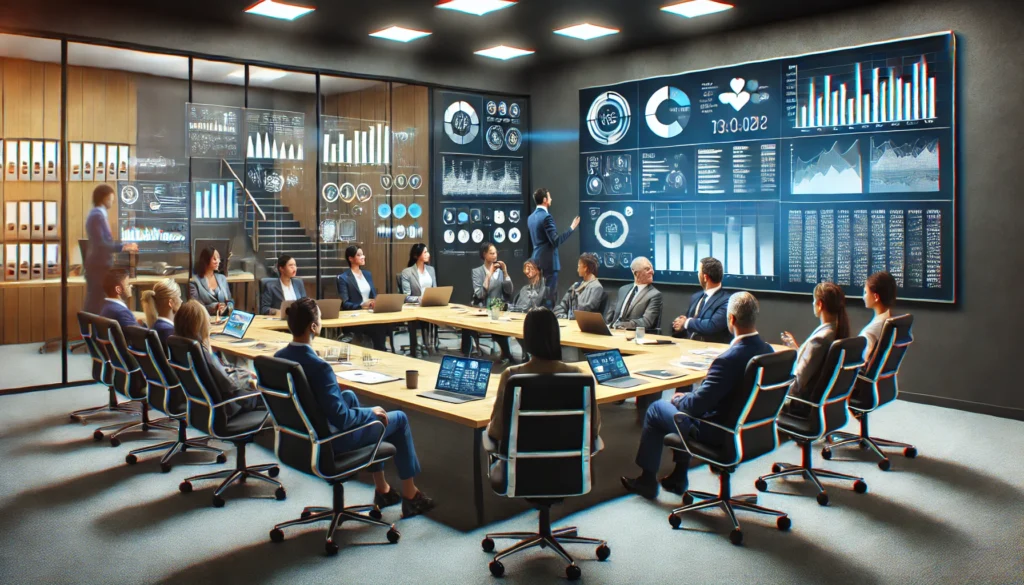Planning a successful business meeting is akin to orchestrating a symphony where each element plays a pivotal role in the harmony of the overall performance. Meetings are an integral part of the corporate landscape, offering opportunities for collaboration, decision-making, and strategy development. However, the efficacy of a meeting is often contingent on meticulous planning and execution. In this article, we’ll explore key strategies for planning and conducting successful business meetings, ensuring that they are both productive and engaging.
You may also like: How to Keep Meetings Focused and Efficient
Understanding the Purpose of Your Meeting
Before diving into the logistical details of scheduling a meeting, it is imperative to clearly define its purpose. Is the meeting intended to solve a problem, brainstorm new ideas, or provide updates on project progress? Understanding the primary objective will guide the rest of the planning process, from deciding on the meeting format to setting the agenda and inviting the right participants.
Identifying the Core Objective
The first step in understanding your meeting’s purpose is to identify its core objective. This involves determining whether the meeting’s aim is to make decisions, gather input, or disseminate information. Clearly defining the objective helps in shaping the structure and flow of the meeting, ensuring that it stays on track and achieves its intended goals.
Aligning the Meeting with Organizational Goals
Once the core objective is identified, it’s crucial to align the meeting’s purpose with the broader organizational goals. This alignment ensures that the meeting contributes positively to the company’s strategic direction and maximizes its impact. By linking the meeting to organizational objectives, you create a sense of relevance and urgency among participants.
Assessing the Need for the Meeting
Before proceeding, assess whether a meeting is truly necessary. Sometimes, a quick email or a brief phone call can achieve the desired outcome more efficiently. Consider the complexity of the issues at hand and the need for real-time interaction to determine if a meeting is the most appropriate forum for discussion.
Setting Clear Objectives
To ensure that your meeting achieves its goals, establish clear objectives. These should be specific, measurable, attainable, relevant, and time-bound (SMART). For instance, rather than stating a vague goal like “discuss sales,” a more effective objective would be “analyze quarterly sales data and identify two strategies to increase sales by 15% in the next quarter.” This level of specificity helps maintain focus and provides a benchmark for measuring the meeting’s success.
Defining Specific Goals
When setting objectives, specificity is key. Clearly define what you want to accomplish during the meeting. For example, if the goal is to develop a marketing strategy, specify which aspects of the strategy will be discussed and what outcomes are expected. Specific goals provide clarity and direction, reducing ambiguity and confusion.
Establishing Measurable Outcomes
Measurable outcomes are essential for assessing the success of a meeting. These outcomes might include actionable items, decisions made, or consensus reached on certain issues. By establishing measurable outcomes, you create a framework for evaluating the meeting’s effectiveness and determining whether it met its objectives.
Ensuring Objectives are Attainable and Relevant
Objectives must be realistic and relevant to the participants and the organization. Setting unattainable goals can lead to frustration and disengagement, while irrelevant objectives may result in wasted time and resources. Ensure that your meeting’s objectives are within reach and align with the participants’ capabilities and interests.
Crafting an Effective Agenda
An agenda is the backbone of any successful meeting. It provides structure, ensures that all necessary topics are covered, and helps keep participants on track. When creating an agenda, prioritize topics based on their importance and relevance to the meeting’s objectives. Allocate time for each agenda item and include a buffer for questions and discussions to encourage participant engagement.
Prioritizing Agenda Items
Start by listing all potential topics for discussion, then prioritize them based on their importance and urgency. Consider the meeting’s objectives and allocate more time to the most critical issues. Prioritizing topics ensures that the meeting remains focused and that essential matters are addressed first.
Allocating Time Effectively
Each agenda item should have a designated time slot to prevent the meeting from running over. Be realistic about how long discussions will take, and include buffer time for unforeseen complications. Effective time allocation helps maintain the meeting’s pace and ensures that all topics are covered within the allotted time.
Including Opportunities for Interaction
To enhance engagement, incorporate opportunities for interaction within the agenda. This might involve scheduling time for questions, group discussions, or collaborative activities. Interactive elements foster a more dynamic meeting environment and encourage participants to contribute their ideas and perspectives.
Distributing the Agenda in Advance
Once the agenda is finalized, distribute it to all participants well in advance of the meeting. This not only prepares attendees for the discussion but also allows them to gather any necessary information or materials beforehand. Additionally, sharing the agenda encourages participants to come with questions or suggestions, fostering a more interactive and dynamic meeting environment.
Encouraging Pre-Meeting Preparation
By providing the agenda in advance, you encourage participants to prepare for the meeting. This preparation might involve reviewing relevant documents, conducting research, or formulating questions and ideas. Well-prepared participants contribute more effectively to discussions and decision-making processes.
Gathering Feedback and Input
Distributing the agenda beforehand also opens the door for feedback and input from participants. Encourage attendees to suggest additional topics or propose modifications to the agenda. This collaborative approach ensures that the meeting addresses all relevant issues and reflects the participants’ needs and priorities.
Setting Expectations for Participation
An advanced agenda sets clear expectations for participation. Participants are aware of the topics to be covered and can anticipate their role in the discussion. This clarity helps reduce anxiety and confusion, enabling attendees to engage more confidently and contribute meaningfully to the meeting.
Selecting the Right Participants
Inviting the appropriate participants is crucial for a successful meeting. Consider who needs to be present to achieve the meeting’s objectives and contribute valuable insights. While it’s important to include key stakeholders, be mindful of over-inviting, as too many participants can lead to a lack of focus and inefficiency.
Identifying Key Stakeholders
Begin by identifying the key stakeholders who need to be involved in the meeting. These individuals are typically decision-makers or those with expertise relevant to the meeting’s objectives. Their presence ensures that discussions are informed and that decisions can be made efficiently.

Balancing Inclusivity with Efficiency
While it’s important to include a diverse range of perspectives, too many participants can hinder the meeting’s efficiency. Strive to balance inclusivity with the need for a focused, productive discussion. Consider limiting the participant list to those whose input is essential for achieving the meeting’s goals.
Communicating Roles and Responsibilities
Clearly communicate the roles and responsibilities of each participant in advance. This might involve assigning specific tasks or topics for discussion. By defining roles, you ensure that participants are prepared to contribute effectively and that the meeting proceeds smoothly.
Encouraging Active Participation
To maximize the effectiveness of your meeting, encourage active participation from all attendees. This can be achieved by assigning roles, such as timekeeper or note-taker, to keep everyone engaged. Additionally, consider incorporating interactive elements, such as polls or breakout sessions, to facilitate collaboration and ensure diverse perspectives are heard.
Assigning Meeting Roles
Assigning specific roles to participants can enhance engagement and ensure that the meeting runs smoothly. Roles such as facilitator, timekeeper, and note-taker help maintain order and focus. Clearly defined roles also provide participants with a sense of responsibility and encourage active involvement.
Incorporating Interactive Elements
Interactive elements, such as polls, quizzes, or breakout sessions, can energize participants and promote collaboration. These activities break the monotony of traditional meetings and encourage attendees to express their ideas and opinions. By fostering interaction, you create a more dynamic and engaging meeting environment.
Creating a Safe Space for Contributions
Ensure that the meeting environment is conducive to open and honest communication. Encourage participants to share their thoughts and ideas without fear of judgment. By creating a safe space for contributions, you empower attendees to engage actively and contribute to the meeting’s success.
Choosing the Optimal Meeting Format
The format of your meeting should align with its objectives and participants’ needs. For instance, a brainstorming session may benefit from a more informal, open-discussion format, while a presentation of quarterly results might require a structured, formal approach. Additionally, consider whether a virtual or in-person meeting is more appropriate, taking into account factors such as location, participant availability, and technological capabilities.
Evaluating Different Formats
Evaluate various meeting formats to determine which best suits your objectives and participants. Consider factors such as the nature of the discussion, the number of participants, and the desired outcomes. Different formats, such as roundtable discussions, workshops, or webinars, offer distinct advantages and can be tailored to meet specific needs.
Balancing Form and Function
The chosen meeting format should balance form and function, ensuring that it facilitates productive discussions and decision-making. For example, a formal presentation might be appropriate for conveying information, while an informal roundtable may be better suited for generating ideas. Align the format with the meeting’s purpose to maximize its effectiveness.

Considering Virtual vs. In-Person Meetings
Decide whether a virtual or in-person meeting is more appropriate based on logistical considerations. Virtual meetings offer flexibility and convenience, while in-person meetings may foster stronger interpersonal connections. Weigh the pros and cons of each option to determine which best aligns with the meeting’s objectives and participants’ needs.
Leveraging Technology for Virtual Meetings
In today’s digital age, virtual meetings have become increasingly prevalent. To ensure their success, invest in reliable technology and ensure all participants are comfortable using the chosen platform. Additionally, establish clear guidelines for virtual etiquette, such as muting microphones when not speaking and using video to enhance engagement.
Selecting the Right Technology
Choose a virtual meeting platform that meets the needs of your participants and supports the meeting’s objectives. Consider factors such as ease of use, reliability, and available features. Platforms like Zoom, Microsoft Teams, and Google Meet offer various tools to facilitate virtual collaboration.
Ensuring Participant Comfort and Competence
Provide training or resources to ensure participants are comfortable using the chosen platform. Familiarity with the technology enhances engagement and reduces technical difficulties. Encourage participants to test their equipment and internet connection before the meeting to minimize disruptions.
Establishing Virtual Meeting Etiquette
Set clear guidelines for virtual meeting etiquette to maintain professionalism and order. Encourage participants to use video to enhance engagement and establish a connection. Remind attendees to mute microphones when not speaking and to use chat features or hand-raising for questions.
Managing Time Effectively
Time management is a critical component of a successful meeting. Adhering to the allotted time for each agenda item ensures that the meeting remains focused and productive. To avoid overruns, designate a timekeeper to monitor the schedule and gently steer discussions back on track if they begin to veer off course.
Designating a Timekeeper
Appoint a timekeeper to monitor the meeting’s schedule and ensure that discussions remain on track. The timekeeper’s role is to provide gentle reminders when time limits are approaching, helping to maintain focus and prevent overruns. This role is crucial for keeping the meeting organized and productive.
Setting Realistic Time Limits
When creating the agenda, set realistic time limits for each topic. Consider the complexity of the issues and the number of participants involved. By setting achievable time limits, you ensure that discussions are thorough yet efficient, allowing for a comprehensive exploration of each topic.
Addressing Time Overruns
Despite careful planning, time overruns can occur. When this happens, assess whether the discussion warrants additional time or if it should be tabled for a later meeting. Flexibility is key, but maintaining overall time discipline ensures that the meeting remains productive and respects participants’ schedules.

Incorporating Breaks and Buffer Time
Long meetings can be taxing on participants, leading to diminished attention and engagement. To combat this, incorporate short breaks to allow attendees to recharge. Additionally, include buffer time within the agenda to accommodate any unexpected delays or in-depth discussions, ensuring that all topics are thoroughly addressed without feeling rushed.
Scheduling Regular Breaks
For meetings longer than an hour, schedule regular breaks to allow participants to rest and recharge. Short breaks can improve focus and prevent fatigue, leading to more productive discussions. Encourage participants to step away from their screens and move around during these breaks.
Allowing for Buffer Time
Include buffer time in the agenda to accommodate unexpected delays or extended discussions. This flexibility ensures that all topics are covered without feeling rushed. Buffer time also allows for a more relaxed and open discussion, fostering creativity and collaboration.
Maintaining Participant Engagement
Use breaks and buffer time strategically to maintain participant engagement. Encourage interactive activities or informal discussions during breaks to keep energy levels high. By maintaining engagement throughout the meeting, you ensure that participants remain focused and motivated.
Following Up After the Meeting
The conclusion of a meeting does not signify the end of the process. Follow-up is essential for reinforcing decisions made and ensuring that action items are executed. Shortly after the meeting, distribute a summary of key points and action items, assigning responsibilities and deadlines to relevant participants. This helps maintain momentum and accountability, driving progress toward the meeting’s objectives.
Distributing Meeting Summaries
Send out a summary of the meeting shortly after it concludes, highlighting key points and decisions made. Include action items, responsibilities, and deadlines to ensure clarity and accountability. Meeting summaries provide a reference for participants and help maintain momentum.
Assigning Responsibilities and Deadlines
Clearly assign responsibilities and deadlines for each action item to relevant participants. This accountability ensures that tasks are completed and that progress is made toward the meeting’s objectives. Regularly follow up on action items to track progress and address any challenges.
Ensuring Accountability and Progress
Establish a system for tracking the completion of action items and evaluating progress. This could involve regular check-ins or status updates to ensure that tasks are on track. By maintaining accountability, you reinforce the importance of the meeting and drive the implementation of decisions made.
Evaluating Meeting Effectiveness
To continually improve your meetings, solicit feedback from participants on what worked well and areas for improvement. This can be done through a brief survey or informal discussion. Use this feedback to refine your approach, ensuring that future meetings are even more effective and engaging.
Gathering Participant Feedback
After the meeting, gather feedback from participants on their experience. Use surveys, questionnaires, or informal discussions to solicit input on what worked well and what could be improved. Participant feedback is invaluable for identifying strengths and areas for development.
Analyzing Feedback for Improvement
Carefully analyze the feedback received to identify patterns and areas for improvement. Consider both positive and negative comments to gain a comprehensive understanding of the meeting’s effectiveness. Use this analysis to refine your approach and enhance future meetings.
Implementing Changes for Future Meetings
Based on the feedback and analysis, implement changes to improve future meetings. This might involve adjusting the format, refining the agenda, or enhancing participant engagement strategies. Continuously refining your approach ensures that meetings remain productive and valuable.
Conclusion
Conducting successful business meetings requires careful planning, clear communication, and active participation. By understanding the meeting’s purpose, crafting a structured agenda, selecting the right participants, and leveraging appropriate technology, you can create a productive and engaging meeting environment. Remember, the key to success lies not only in the meeting itself but also in the follow-up actions that drive the implementation of decisions made. With these strategies in mind, you’re well on your way to orchestrating meetings that resonate like a well-played symphony, achieving harmony and success in your professional endeavors.
Further Reading:
4 Types of meetings every business owner must have
How to Have a Successful Business Meeting in 2025
Business Meetings: The Definitive Guide for 2024
Important Note: The information contained in this article is for general informational purposes only, and should not be construed as health or medical advice, nor is it intended to diagnose, prevent, treat, or cure any disease or health condition. Before embarking on any diet, fitness regimen, or program of nutritional supplementation, it is advisable to consult your healthcare professional in order to determine its safety and probable efficacy in terms of your individual state of health.
Regarding Nutritional Supplements Or Other Non-Prescription Health Products: If any nutritional supplements or other non-prescription health products are mentioned in the foregoing article, any claims or statements made about them have not been evaluated by the U.S. Food and Drug Administration, and such nutritional supplements or other health products are not intended to diagnose, treat, cure, or prevent any disease.


